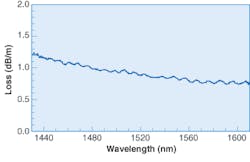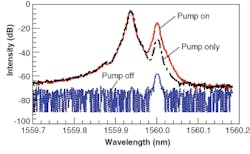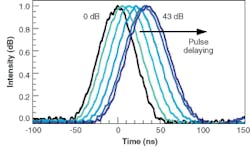MID-IR FIBERS: Chalcogenide fiber slows light
KAZI S. ABEDIN
When used as the basis for nonlinear optical devices, single-mode optical fiber inherently provides the high light intensities needed for a good nonlinear response. Such fiber-based devices can be used in many optical-signal-processing applications. Optical properties that strongly influence the suitability of a fiber for these uses include the fiber’s spectral-transparency range, chromatic dispersion, and nonlinear properties such as its Kerr, Raman, and Brillouin coefficients. While such fibers are commonly based on silica, certain nonsilica-based glass materials have enhanced nonlinear properties that make them quite attractive for use in signal-processing applications such as wavelength conversion, ultrafast optical switching, optical regeneration, parametric and Raman amplifications, and slow-light devices.1-3
For nonlinear applications, it is desirable to have fibers with a large nonlinear response, which allows the optical-power requirement as well as the device length to be reduced. The nonlinear response of an optical fiber can be enhanced not only by tightly confining light in a small core, but also by using a material with large nonlinear coefficients. To this end, several nonsilica glasses-which include tellurite, bismuth, and chalcogenide glass fibers with enhanced nonlinear optical properties-have been drawn into optical fibers and used in nonlinear devices.
Single-mode chalcogenide fiber
Among the types of nonsilica glass fibers developed so far, chalcogenide glass is particularly well-known because of its large nonlinear Kerr, Raman, and Brillouin coefficients, which are about two orders of magnitude larger than those of silica fibers; in addition, the material’s optical-transmission range extends to beyond 10 µm. Chalcogenide glasses are composed of one or more chalcogen elements such as sulfur, selenium (Se), and tellurium, along with other elements, such as arsenic (As), gallium, germanium, indium, and antimony, to form stable glasses. Other elements such as phosphorus, iodine, chlorine, bromine, and cadmium are sometimes added to these glasses to tailor the optical, mechanical, and thermal properties.
Researchers at the Naval Research Laboratory (Washington, D.C.) pioneered the drawing of optical fibers from As2Se3 glass using the so-called “double-crucible” process, which results in an extremely large nonlinear coefficient n2 of about 500 times larger than that for silica.4 But while the fibers-with core size of about 7 to 12 µm-were single-mode at longer IR wavelengths, they were multimode in the telecommunications wavelength region near 1.55 µm. For stable all-optical signal-processing applications, fibers that behave as single-mode are highly desired.
More recently, single-mode chalcogenide fibers with low loss at a 1.55 µm wavelength were drawn by CorActive High-Tech (Quebec City, Que., Canada) from high-purity material using the double-crucible process, where the core was made from As39Se61 and the cladding from similar material, but with a slightly reduced As content (see Fig. 1). Black in color, the fiber has a typical core/cladding diameter of 6/167 µm, a refractive index of about 2.8, and a numerical aperture of 0.18, allowing single-mode propagation through the fiber in the 1.55 µm wavelength range. The measured transmission loss in the 1440 to 1600 nm wavelength range is about 1.2 to 0.8 dB/m over that range.5
null
null
Stimulated Brillouin scattering in As2Se3 fiber
Chalcogenide optical fiber has a large third-order-nonlinearity Kerr effect, which makes it attractive for realizing compact fiber devices used in ultrafast signal processing. Indeed, several applications of this fiber based on Kerr effects have been demonstrated, including wavelength conversion and optical regeneration.6, 7
Another nonlinear phenomenon, known as stimulated Brillouin scattering (SBS), involves scattering of narrowband laser radiation in the backward direction inside the fiber. In this case, the light that is scattered in the backward direction experiences a frequency downshift (the Stokes shift) by an amount determined by nB= 2nvA/λp, where vA is the acoustic velocity, n is the refractive index, and λp is the pump wavelength. The SBS effect can be used to amplify a narrowband (typically a few tens of megahertz) optical signal (corresponding to the Stokes wave) by propagating in a direction opposite to the pump. This effect has found application in many optical components such as Brillouin amplifiers, lasers, and distributed fiber sensors, as well as phase conjugators and slow-light devices.2, 3
Nonlinear effect slows light
The narrow bandwidth over which Brillouin amplification occurs causes a significant increase in the group index within the gain band, introducing additional group delay in the signal. The propagation time of an optical pulse within a fiber of length L is L/vg, where vg is the group velocity (this is equivalent to Lng/c, where ngis the group refractive index and c is the speed of light.). Because the amount of change in the refractive index is proportional to the intensity of the pump light (that is, the excited light), it is possible to continuously change the propagation (and hence the delay time) within the optical fiber by adjusting the incident light intensity.
Brillouin amplification in the As2Se3 fiber, necessary for slow-light generation, can be readily observed by launching a strong continuous-wave pump and weak counterpropagating probe signal inside a fiber about 5 m in length (see Fig. 2). When a pump wave and a probe signal with an optical frequency set 7.958 GHz (νB) below the pump wave were simultaneously launched in the fiber, we observed a Brillouin gain of about 42 dB for a pump power of 68 mW.8 This corresponds to an SBS-induced gain of 0.62 dB/mW of pump power. Material with such a high Brillouin gain coefficient is attractive in reducing the fiber length required for optical delay, which can suppress the effects of environmental perturbation.
null
Efficient slow-light generation in AsSe fiber
In our experiment, the light from the laser was split into two beams; one of the beams was amplified and used as the excited light for Brillouin amplification, and the other was used for generating the signal light pulses (50 ns width, 1 MHz repetition rate) using a phase modulator and an intensity modulator.9 The two beams were then coupled into the 5-m-long chalcogenide fiber from opposite directions, and the delay induced by the pump light was observed by monitoring the waveform of the amplified (Stokes) signal as the pump power was gradually increased.
The results of the experiment showed that the propagation time of the signal light pulse passing though the fiber could be delayed by 37 ns inside the 5‑m-long chalcogenide fiber for a mean power level of the excited light of only 60 mW (see Fig. 3). This indicates that light within the optical fiber was slowed to approximately half its normal speed; it was also confirmed that propagation time could be freely controlled by adjusting the intensity of the injected excited light. Furthermore, the efficiency of time-delay generation per unit length and unit excitation power (ns/m/mW) was approximately 200 times higher than in conventional silica optical fibers.
The results of the experiment have contributed to significant progress in the practical application of the “light buffer”-an essential element in the realization of future communication systems based on all-optical signal processing. Based on the success of current R&D efforts, we hope there will be steady progress in resolving the remaining technical issues, such as the microfabrication of optical-fiber cores, improving the scattering efficiency of the materials, and expansion of bandwidth.
REFERENCES
1. G. P. Agrawal, Nonlinear Fiber Optics, Academic Press, CA (1995).
2. K. Y. Song et al., Optics Express 13, 82 (2005).
3. Y. Okawachi et al., Phy. Rev. Lett. 94, 153902 (2005).
4. R. E. Slusher et al., J. Opt. Soc. Am. B 21, 1146 (2004).
5. K. S. Abedin, Optical Fiber Communication Conference 2006, paper OTuH6.
6. L. B. Fu et al., Optics Express 13, 7637 (2005).
7. V. G.Ta’eed et al., Optics Express 14, 10371 (2006).
8. K.S. Abedin, Optics Letters 31, 1615 (2006).
9. K. S. Abedin et al., Conference on Lasers and Elecro-Optics 2006, postdeadline paper CPDA9.
KAZI S. ABEDIN is a senior researcher at the National Institute of Information and Communications Technology (NICT), 4-2-1, Nukui-Kitamachi, Koganei, Tokyo 184-8795, Japan; e-mail: [email protected]; www.nict.go.jp.




